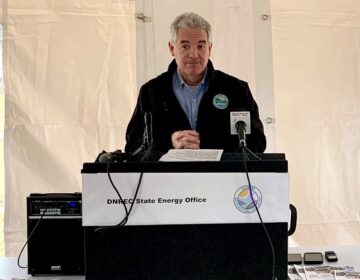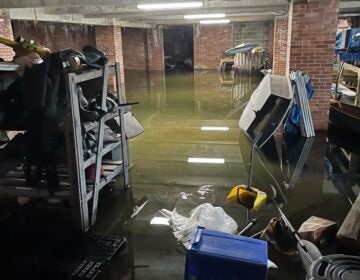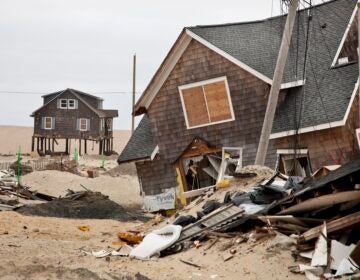2024 tied for Philly’s warmest year on record
Since 2020, Philly has consistently had one of its top 10 warmest years on record.

A sunrise in Philadelphia in 2022. (Danya Henninger/Billy Penn)
This story is part of the WHYY News Climate Desk, bringing you news and solutions for our changing region.
From the Poconos to the Jersey Shore to the mouth of the Delaware Bay, what do you want to know about climate change? What would you like us to cover? Get in touch.
The year that just ended was extraordinarily warm in the Philadelphia region and around the globe.
The city of Philadelphia experienced its warmest year on record, tied with 2012. Pittsburgh’s average temperature shattered the city’s previous record.
The Harrisburg area tied for its second warmest year on record, while parts of South Jersey and northern Delaware saw their third, fourth or fifth warmest years.
“We’re cooking,” said New Jersey State Climatologist David Robinson. “And we continue to do so.”
2024 is the latest in a series of warm years for the Philadelphia region and the globe. Human-caused climate change is driving temperatures higher, and the recent El Niño event contributed to the balmy streak.
2024 is expected to be the warmest year on record globally — and could be the first to pass a key warming threshold.
Another warm year in the Philly region
All but a handful of weather stations in Pennsylvania, New Jersey and Delaware documented one of their top five warmest years in 2024.
Average temperatures in Philadelphia during 2024 were the city’s warmest in 151 years of record keeping, tied with 2012. Several other cities in New York, West Virginia and Pennsylvania — including Pittsburgh, Scranton and Bradford — tied or broke their temperature records.
The year got off to a mild start in the Philly area with one of the city’s warmest and wettest winters on record.
“[Philly] had a very wet spring, and that really helped to hold down temperatures,” said Shel Winkley, a meteorologist at the nonprofit Climate Central. “But we got to summer and right out the gate, we had a big heat wave.”
An excessive heat warning in June prompted the city to open cooling centers. Then, the city saw its third-warmest fall on record. A cold snap in late December left that month’s average temperature slightly colder than normal.
The city’s average temperature in 2024 was 2.6 degrees Fahrenheit above normal.
Even before 2024, six of Philly’s 10 warmest years on record had occurred in the last decade. All but one occurred since the 1990s.
Globally, all 10 of the warmest years on record have occurred in the last decade.
2024 is set to be the world’s warmest year on record, bumping 2023 out of the top spot.
“It’s going to beat [2023] — both of which are heads and tails above previous records,” Robinson said. “Climatologists are still trying to figure out exactly why both these years have been so warm.”
There’s “absolutely no question” that human-caused climate change was the main driver, Robinson said. The recent El Niño event — which releases heat from the eastern Pacific Ocean to the atmosphere — also contributed. Scientists are still trying to figure out what else may have helped push temperatures so high, with theories such as low cloud cover to bounce back the sun’s heat, water vapor from a 2022 volcanic eruption trapping heat on the earth’s surface, or an increase in the solar cycle bringing higher-than-usual radiation from the sun.
A historically dry fall
Drought gripped the Philadelphia region this fall, with Philly and several other cities seeing their driest Octobers on record. No measurable rain fell in Philly that month.
Reservoirs and groundwater levels in the region declined. Salty water crept up the Delaware River, toward Philly’s main drinking water intake. Some water customers in New Jersey were forced to conserve water, while firefighters in that state battled an unseasonably high number of wildfires. Early this month, the Delaware River Basin Commission declared a “water supply emergency.”
Several inches of rain have fallen since October, and reservoir levels have improved. But the region is not out of the woods yet, Robinson said.
“We haven’t begun to chip away at the deficits,” he said. “We’ve lost two months of precipitation over the last five or six months … Just because it’s raining, doesn’t mean the drought concerns have ended.”
If water supplies haven’t improved substantially by the spring, restrictions on water use could be put in place to prepare for summer, when water use peaks, Robinson said.
While climate change is making the northeastern U.S. warmer and wetter overall, droughts continue to be a normal part of the mid-Atlantic climate. Climate change can actually make droughts more intense, because warmer temperatures spur more evaporation.
Dry conditions can in turn contribute to warmer temperatures, Winkley said.
“Rain is a cooling mechanism,” he said. “When you have a very dry ground … the ground heats up quickly, which in turn heats up the air around us … It’s kind of a feedback loop.”
Approaching a key warming threshold of 1.5 degrees
2024 could be the first year that the global temperature averages more than 1.5 degrees Celsius above pre-industrial levels — a level of warming that countries have agreed to try not to exceed.
But passing that threshold temporarily does not mean the goal has been missed. Longer-term warming measured over decades is still below 1.5 degrees C.
“A one-off year doesn’t quite make it,” Winkley said. “It has to be a consistent string of years to be above 1.5 [degrees C], and we’ll know that we’ve reached that tipping point.”
Scientists say at this point, it’s increasingly unlikely — but not impossible — for the world to avoid 1.5 degrees C of warming, as current policies put the world on track to exceed it.
But the exact temperature threshold is not an on-off switch for climate impacts.
“There’s nothing magical about it,” Robinson said. “It’s just an arbitrary value.”
Still, scientists have warned that beyond 1.5 degrees C of warming, the risk of dangerous climate impacts — including drought, devastating storms, extreme heat waves and tipping points such as ice loss that dramatically raises sea levels — increases.
Researchers with World Weather Attribution found that climate change made more than two dozen extreme weather events in 2024, including heat waves, heavy rain and drought, more likely or more severe.
Approaching the 1.5 degree C threshold is a reminder that humans need to move faster to slash greenhouse gas emissions that come from burning coal, oil and gas, Winkley said. Every fraction of a degree of warming that humans can avoid matters for reducing the dangers.
“You’ve seen the extreme weather, you’ve felt the extreme heat and you’ve seen how climate change can make an impact to the places we live and the weather events that we live through,” Winkley said. “That’s the reason why we need to work to bring the temperature down.”

Subscribe to PlanPhilly
WHYY is your source for fact-based, in-depth journalism and information. As a nonprofit organization, we rely on financial support from readers like you. Please give today.









